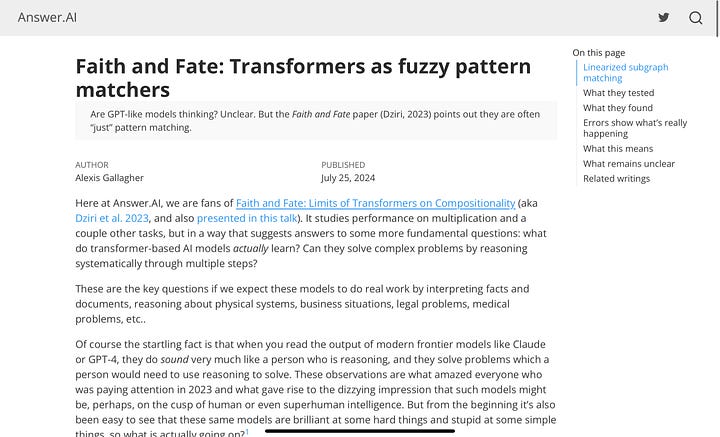Fascinating insights on how LLMs problem-solve
Did you ever wonder how LLMs learn and solve problems? Key takeaways from a fascinating study
Have you ever wondered how Large Language Models (LLMs) like ChatGPT and Claude actually learn and solve problems? A recent article on answer.ai (summarizing a study by Dziri et al. 2023) sheds light on this intriguing question, revealing some surprising insights into the inner workings of these complex systems.
How humans learn and solve problems
Before we dive into the AI world, let's briefly recap how we, as humans, typically approach learning and problem-solving (based on my experience of being human, not the study):
We often break down complex problems into smaller, manageable steps.
We learn and apply specific procedures, heuristics, or algorithms to solve problems.
Once we understand a concept or method, we can usually apply it to similar, more complex problems.
For example, when we learn multiplication, we start with simple problems (2*2) and gradually work our way up to more complex ones (138,063*3,801). We internalize the multiplication algorithm and can then apply it to multiply any two numbers, regardless of their size.
Of course, we're only human. So, again speaking from personal experience, when faced with more complex problems, we often:
Jump to conclusions
Start without breaking down the problem
Get lost in unnecessary details
Apply the wrong heuristic to the wrong problem
Nobody's perfect, so it's worth acknowledging how we sometimes struggle with complexity.
Interestingly, LLMs learn and problem-solve quite differently
Now, here's where it gets interesting. According to the Dziri et al. study, LLMs approach problems quite differently from our human brains:
Instead of reasoning systematically, LLMs primarily rely on recognizing and matching patterns they've seen in their training data.
LLMs do break down problems into smaller parts, but then try to match these parts with similar patterns they've encountered before (what the researchers call "linearized subgraph matching").
Unlike humans, LLMs struggle to generalize from simple problems to more complex ones. For instance, they might do a good job at multiplying small numbers but fail when faced with larger ones.
LLMs often focus on superficial patterns rather than deep, systematic understanding.
To illustrate this with the multiplication example: LLMs might correctly predict the last digit of the result based on the last digits of the factors. But they would not understand the underlying algorithm of how numbers are actually multiplied.
I found this truly fascinating. If you've used LLMs yourself (which you likely have by now), you know that they can provide brilliant insights, while also being inconsistent, delivering mixed results and making surprisingly basic errors. Always good to get a more grounded understanding of WHY this happens.
All opinions are my own. Please be mindful of your company's rules for AI tools and use good judgment when dealing with sensitive data.
Screenshots: Respective websites, via me





